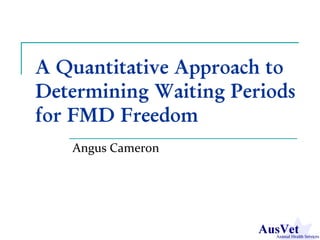
Session 2: A Quantitative approach to determining waiting period for FMD freedom
- 1. A Quantitative Approach to Determining Waiting Periods for FMD Freedom Angus Cameron
- 2. Conclusions Quantitative calculation of appropriate waiting periods is possible Need to change standard used to assess surveillance From surveillance sensitivity to probability of freedom Appropriate waiting periods depend on Sensitivity of ongoing surveillance activities Probability of introduction of infection Use of vaccination
- 3. Overview Waiting periods Surveillance standards Calculations Implications
- 4. Waiting periods OIE Code for FMD Periods of 3, 6, 12, 18, 24 months depending on situation What is the purpose? How were they determined? Are they correct?
- 5. Purpose of waiting periods Allow disease to spread Reach a detectable level (design prevalence) Non-vaccinated non-immune population Rapid spread, very short period required Vaccinated population Slower spread, may require more time Allow disease to be detected by surveillance Ongoing surveillance (e.g. passive farmer reporting) More time = more surveillance = more confidence
- 6. Time and confidence in freedom Intuitive principles 1. Old surveillance loses value 2. Confidence accumulates over time How to describe these effects quantitatively?
- 7. Quantifying effects of time Decrease of value of old surveillance Example: Serosurvey achieving 95% surveillance sensitivity No positive animals detected Scenario 1: Completed one month ago Are we confident that the population is free now? Scenario 2: Same survey conducted 5 years ago Are we confident that the population is free now?
- 8. Decay in confidence with time Due to risk of introduction of disease Perfect biosecurity No loss in confidence
- 9. Accumulation in confidence Ongoing surveillance activities Passive farmer reporting Abattoir surveillance Active negative clinical reporting Individual observations Relatively low sensitivity Longer waiting time More observations, higher surveillance sensitivity
- 10. Surveillance standards: Traditional approach Surveillance sensitivity Pr(S+ | D+) Probability of detecting at least on positive animal given that the population is infected at the design prevalence Only standard used in OIE code Sometimes called ‘confidence’ Usually set at 95%
- 11. Surveillance sensitivity Contributing factors Sample size Individual test sensitivity Design prevalence Risk-based sampling Does not capture effect of time
- 12. Surveillance standards: Alternative approach Probability of freedom Pr(D- | S-) Probability that the population is free from disease (at the design prevalence), given that surveillance found no positive animals Calculated using Bayes’ Theorem Intuitively easier for regulators to understand
- 13. Probability of freedom Contributing factors Surveillance sensitivity Sample size, design prevalence, test Se, risk-based sampling Multiple surveillance activities e.g. serosurveillance + passive reporting + abattoir Accumulation of historical evidence over time Risk of introduction of disease over time
- 14. Calculation
- 15. 1 0.9 0.8 SSSe 0.7 Probability P(free) 0.6 P(intro) 0.5 0.4 0.3 0.2 0.1 0 0 1 2 3 4 5 6 7 8 9 10 11 12 13 14 15 16 Time Period
- 16. Tools for calculation Free on-line tool to do calculations Multiple surveillance components Multiple time periods Herd-level data Herd- and animal-level risk based sampling http://epitools.ausvet.com.au Access currently limited while under development Will be made public on completion of project
- 22. Implications Time to target probability of freedom Shorter with Higher sensitivity surveillance Larger sample size Good risk-based sampling Higher sensitivity test system Higher design prevalence More surveillance components Lower probability of introduction
- 23. Calculating appropriate waiting periods 1. Set target probability of freedom 2. Identify surveillance components contributing evidence of freedom 3. Estimate sensitivity of each component 4. Estimate probability of introduction 5. Calculate time to achieve target
- 24. Freedom with vaccination Effects of vaccination Lower within-herd design prevalence Lower sensitivity of clinical surveillance Result Lower surveillance sensitivity Longer waiting period required
- 25. Conclusions Quantitative calculation of appropriate waiting periods is possible Need to change standard used to assess surveillance From surveillance sensitivity to probability of freedom Appropriate waiting periods depend on Sensitivity of ongoing surveillance activities Probability of introduction of infection Use of vaccination
- 26. Acknowledgements Tony Martin Evan Sergeant Tripartite workshop participants Turkey Adil ADIGÜZEL Abdulnaci BULUT Bulgaria Pencho KAMENOV Tsviatko ALEXANDROV Greece Achilles SACHPATZIDIS Maria TOPKARIDO EuFMD
